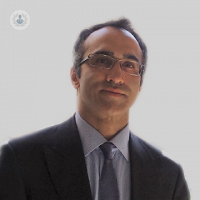Exploring macular hole surgery
Escrito por:In his latest online article, Mr Mahi Muqit gives us his insights into macular hole surgery. He talks about what it is and the procedure, why it might be required, main risks, side effects, results and recovery.

What exactly is macular hole surgery and how is it generally performed?
Let's delve into the topic of an immaculate hall. Initially, let's consider the eye, often likened to a camera, with the film being the retina—a thin layer of light-sensitive cells. The central part of this layer is known as the macula, which plays a pivotal role in various complex visual functions, including reading, colour perception, and everyday tasks. However, in some patients, a condition called macular hole can develop, which involves a small hole forming at the centre of the macula. This condition can result in significant and profound loss of central vision and severe visual distortion, drastically impacting a patient's quality of life.
Treatment for macular hole involves a surgical procedure called vitrectomy. This procedure is routinely performed, typically under local anaesthesia with sedation to ensure patient comfort. It entails making micro-incisions in the eye, removing the vitreous jelly, peeling tissue around the macular hole, and filling the eye with a short-acting gas bubble. The good news is that the success rates for macular hole surgery are very promising, often exceeding 90% and even reaching 95%. Therefore, it is crucial for individuals diagnosed with a macular hole to seek a specialist's evaluation promptly because, if left untreated, macular holes can enlarge over time, leading to further visual deterioration.
It's essential to note that the risks associated with vitrectomy for macular hole surgery are relatively low, and some of them are even lower than those of cataract surgery. In fact, vitrectomy for macular hole repair is among the top five most commonly performed eye surgeries at our institution.
Why might a patient require macular hole surgery?
Patients undergo macular surgery due to the noticeable absence of central vision and the presence of distorted vision. This loss of central vision can make everyday activities, such as reading and recognising faces, extremely challenging. It can be quite unsettling to suddenly experience such a significant loss in this crucial aspect of vision. These patients typically seek an eye examination to confirm the diagnosis, after which we can discuss the details of macular surgery for macular hole repair.
What are the main risks and side effects involved?
The main risks associated with macular surgery, like any eye surgery, are very rare complications, occurring at a rate of approximately one in two thousand cases. These complications can include the risk of infection, which can potentially result in vision loss. However, it's important to note that such rare complications are unlikely to occur.
A more common occurrence following macular surgery is the development of cataracts, which cause the eye's natural lens to become cloudy. Nevertheless, during the consultation, if a patient is of a certain age and already has a cataract, it's possible to address both the cataract and the macular hole during the same surgical procedure. This approach offers patients a faster recovery and quicker restoration of their vision.
I would like to emphasise that the risks associated with this surgery are generally low, and it is a commonly performed procedure.
What results can patients expect and what does recovery time look like?
The expected outcomes for patients undergoing macular surgery are influenced by the size of the macular hole, which can vary in size from small to medium, large, and very large. The majority of macular holes fall into the medium to large category, where the success rate is notably high, ranging between 85% to 90% and potentially even higher. This high success rate means that the macular hole can typically be effectively closed in a significant number of patients.
Consequently, this closure prevents further deterioration of vision and promotes gradual visual recovery. It's important to note that while patients can generally anticipate improved vision following macular surgery, the full extent of visual improvement may take up to a year to become apparent. Unlike solving a jigsaw puzzle where pieces instantly fit together, closing a macular hole is more similar to a process where the cells inside the macula need time to rewire. This rewiring can be a gradual process, and over the months following the operation and up to a year later, patients can expect a steady improvement in their vision.
Additionally, the distortion symptoms may also gradually diminish, although not entirely. Nonetheless, the majority of these symptoms can show improvement within a year.
Mr Mahi Muqit is a distinguished ophthalmologist with over 25 years of experience. You can schedule an appointment with Mr Muqit on his Top Doctors profile.


